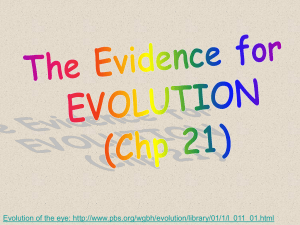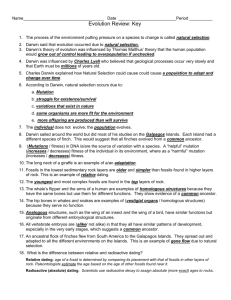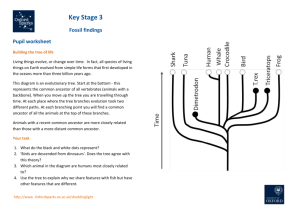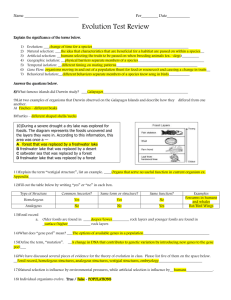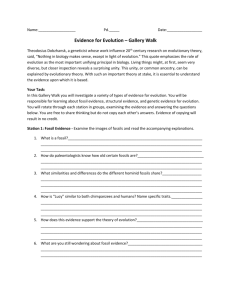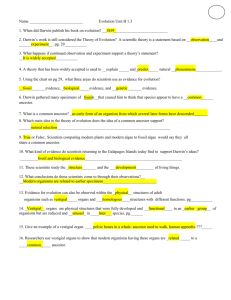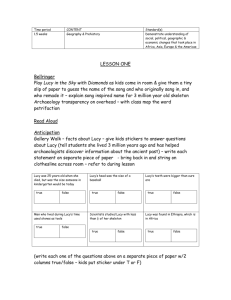Resources: Evidence for Evolution
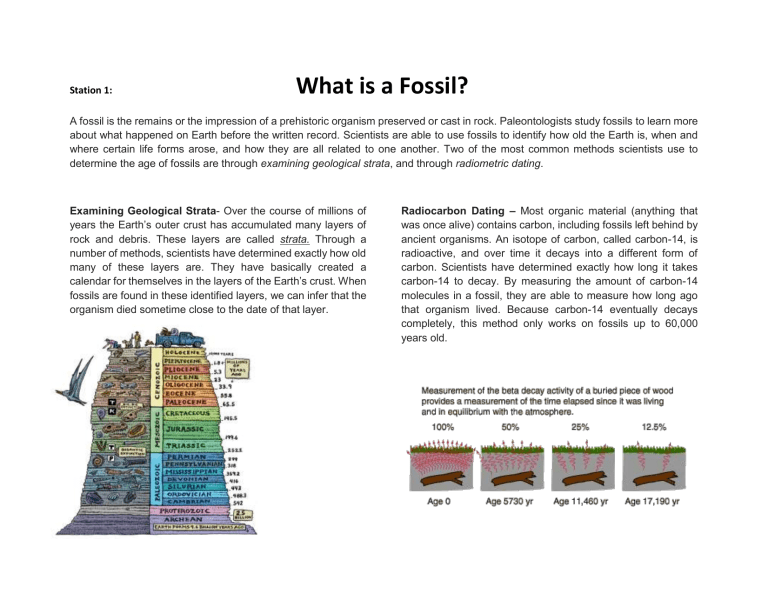
Station 1:
What is a Fossil?
A fossil is the remains or the impression of a prehistoric organism preserved or cast in rock. Paleontologists study fossils to learn more about what happened on Earth before the written record. Scientists are able to use fossils to identify how old the Earth is, when and where certain life forms arose, and how they are all related to one another. Two of the most common methods scientists use to determine the age of fossils are through examining geological strata , and through radiometric dating .
Examining Geological Strata - Over the course of millions of years the Earth’s outer crust has accumulated many layers of rock and debris. These layers are called strata.
Through a number of methods, scientists have determined exactly how old many of these layers are. They have basically created a calendar for themselves in the layers of the Earth’s crust. When fossils are found in these identified layers, we can infer that the organism died sometime close to the date of that layer.
Radiocarbon Dating – Most organic material (anything that was once alive) contains carbon, including fossils left behind by ancient organisms. An isotope of carbon, called carbon-14, is radioactive, and over time it decays into a different form of carbon. Scientists have determined exactly how long it takes carbon-14 to decay. By measuring the amount of carbon-14 molecules in a fossil, they are able to measure how long ago that organism lived. Because carbon-14 eventually decays completely, this method only works on fossils up to 60,000 years old.
“Lucy”
These are the fossil remains of a hominid (relative of humans) that lived between 2.9 and 3.9 million years ago. Although she is quite different from modern day humans, the shape of her skull, her pelvis, and her knee joint have led paleontologists to determine that she walked on two legs, not four.
“Lucy’s” Stats:
Species: Australopithecus afarensis
Home: Fossil remains were found in the deserts of
Ethiopia, in Eastern Africa.
Age: Lucy was probably about 25 years old when she died.
Height: 1.1 meters tall (about 3’7”)
Weight: 29 kilograms (about 67 lb)
Important Features: o By looking at the space inside of Lucy’s skull, scientists have determined that her brain was much smaller than modern humans, and closer to that of modern chimpanzees. o Lucy had a wide pelvis that was similar in shape to modern humans. The shape her pelvis suggests she walked upright. o Lucy’s knee joint is a similar shape to modern humans. It also suggests she walked upright. o The hole at the base of Lucy’s skull (where the spinal cord would exit) also suggests she walked upright.
Chimpanzee “Lucy” Modern human
Other Fossil Hominids
“Taung child” “Hobbit”
Australopithecus africanus Homo floresiensis Homo rudolfensis
About 2.8 million years old Australopithecus africanus About 18,000 years old About 1.9 million years old
Discovered in South Africa Between 2.4 and 2.8 million years old Discovered in Indonesia
“Ardi”
Ardipithecus ramidus
Orrorin tugenensis About 4.4 million years old
About 6 million years old Discovered in Ethiopia
Homo erectus
Between 780,000 and 400,000 years old
Discovered in China
Homo habilis Homo neandertalensis
About 1.9 million years old Between 70,000 and 45,000 years old
Discovered in Kenya Discovered in Spain
Station 2:
Examples of Homologous Structures
Homologous structures are physical features of two or more species that they inherited from a common ancestor. Homologous structures may not necessarily perform the same function, but they share a common ancestral origin.
The bones in the forelimbs of land-dwelling and some aquatic vertebrates (animals with a
backbone) are remarkably similar because they have all evolved from the forelimbs of a common
ancestor. This is an example of homologous structures.
Homologous Structures in Embryos
Many biologists compare the embryos of different species to identify evolutionary relationships. Look at these images and notice similarities and differences across species and at different stages of development.
Homologous structures in plants – One interesting way that plants have evolved and diversified is through their leaves. Although they may seem different, the venus flytrap, the red “petals” of the poinsettia, the spines on a cactus, and the pine needles on an evergreen tree are all modified versions of leaves. This means they’re common ancestor was a plant that had leaves.
Station 3:
DNA Comparisons
Scientists study the DNA of many organisms to help determine evolutionary relationships. If two species have the same mutation in the DNA, it is likely that they evolved from a common ancestor that carried that same mutation. Tracking these mutations in populations can also help scientists understand how populations moved and migrated around the globe.
Examine the following strands of DNA that came from 5 different species. Look for similarities and differences. Then try to predict how they are related to each other (from most to least related). Once you have written your prediction on your worksheet, you may check with Ms. Dignan for the answers.
*Please don’t write on this sheet.
Species 1:
CCAATGGGGCGGGGGCGCTGGGGCTCGCCATATAAGGAGCGGCCTCGCCATAAAAGGAAACATTGTATCTCTTTATA
Species 2:
CCAATCGCAGCGCAGCACTGTGACTCACCATACATGGACAGCCATCACCATATAAGGAAACATCGACTCGCTTTATA
Species 3:
CCAATGGGGCGGGGGCGCTGGGGCTCACCATATAAGGAGCGGCCTCGCCATAAAAGGAAACATTGTATCTCTTTATA
Species 4:
CCAATGGGGCGGGGGCGCTGGGGCTCGCCATATAAGGAGCGGCCTCGCCATAAAAGGAAACATTGTATCTCTTTATA
Species 5:
CCAATCAATAAGCGATACTGTGACTCGCCAAATAAGGAGAGACATCACCAAATAAGGAAGCCTTGTATCTCTTTATA
Answer Key is written in white. Highlight it to see what it is:
Species 1: Rat Species 2: Zebrafish Species 3: Human Species 4: Mouse Species 5: Blowfish
Station 4:
Vestigial Traits
Vestigial traits are parts of an organisms body that they inherited from their ancestors, but that they no longer use. Because individuals who carry these traits are not negatively impacted, they continue to exist within the species, even though they are no longer of any use.
Whales have legs?
Although they never use them, whale skeletons actually have small pelvic bones where their evolutionary ancestor’s legs would have been. This is an example of a vestigial trait.
Vestigial Traits
Vestigial traits are parts of an organism’s body that they inherited from their ancestors, but that they no longer use. Because individuals who carry these traits are not negatively impacted, they continue to exist within the species, even they are no longer of any use.
The appendix: Scientists believe our evolutionary ancestors needed the appendix to aid in digesting certain foods. Our diet has since changed, but we still have this organ. In some people it can become infected and needs to be removed.
The tail bone (coccyx): Humans evolved from other land mammals that had tails. As humans evolved and started to walk upright, the tail got in the way and was selected against. Our tail has decreased to the point where it’s rarely visible accept for in the skeleton. This is why we call it our tail bone!
